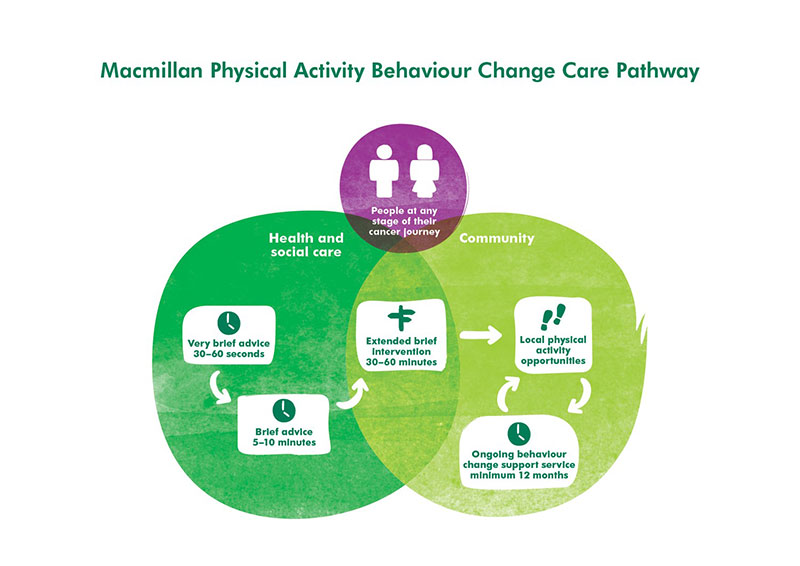By Sarah Worbey. Physical Activity Integration Manager, Macmillan Cancer Support
(in Volume 25)
Presentation Abstract
More than 1 in 3 people will have a cancer diagnosis during their lifetime; 1 in 4 will then struggle with the consequences of treatment and 1 in 2 will have multiple co-morbidities. Physical activity can help prevent and manage these, improving clinical outcomes and quality of life. Macmillan Cancer Support is taking an evidence based approach to helping people who have been diagnosed with cancer become and stay active. The workshop looked at Macmillan’s physical activity behaviour change care pathway approach, how Macmillan’s work is being implemented across Wales and how we can incorporate opportunities for outdoor recreation.
Article
Many people living with and beyond cancer report significant levels of physical, emotional and social problems which physical activity could improve. One in four people report consequences of treatment . 49% people with cancer say they experience depression as a result of their diagnosis . 65% of cancer survivors report that they have to deal with fatigue during and after treatment . These problems impact quality of life, and can result in people utilising health care resources. The evidence for the impact of physical activity on reduction of prevalence of cancer is well established . The impact of physical activity on improving clinical and quality of life outcomes during and after cancer treatment is relatively recent , as is our knowledge of effective interventions . A healthy lifestyle, including physical activity, can:
- Help to prevent and manage some of the consequences of treatment, including fatigue, depression, bone thinning, muscle wasting, blood clots, erectile dysfunction, heart damage4.
- help prevent over 20 long term conditions including breast and colon cancer, type 2 diabetes and cardiovascular disease, and can be used as an adjuvant treatment for example hypertension, depression and COPD.
- Help to reduce social isolation and enable people who want to, to be able to return to work. 43% of those who give up work or change job as a result of cancer diagnosis feel that that they are not physically able to do it, but with the right support many are able to go back to work.
- may help reduce the relative risk of recurrence for some cancers and disease progression for others4, important as one in five women living with and beyond breast cancer will have a recurrence
- 50% of people living with and beyond cancer also have at least one comorbidity5, and physical activity can also be effective in improving other conditions, such as CVD6. This is important as by 2018 the number of people with three or more long term conditions is predicted to rise from 1.9 million to 2.9million.
- There is evidence that people living with and beyond cancer want to become more active, ‘the teachable moment’ want it to be their choice, in an activity that they enjoy, and have tailored support to make this change
 Macmillan’s physical activity ambition is to ensure that everyone living with and beyond cancer are aware of the benefits of physical activity and are enabled to choose to become and to stay active at a level that’s right for them. This means that we want to effect population level behaviour change through both individual and national level influencing across the UK. Our work programme is focused on increasing the awareness of the benefits of physical activity for people living with and beyond cancer, and those with greatest influence on them, including carers and health care professionals.
Macmillan’s physical activity ambition is to ensure that everyone living with and beyond cancer are aware of the benefits of physical activity and are enabled to choose to become and to stay active at a level that’s right for them. This means that we want to effect population level behaviour change through both individual and national level influencing across the UK. Our work programme is focused on increasing the awareness of the benefits of physical activity for people living with and beyond cancer, and those with greatest influence on them, including carers and health care professionals.
We are also working in partnership with Macmillan service development teams to test the scalability of a proven model of intervention based on NICE public health guidance. The approach focuses on enabling and supporting people to make sustained behaviour change; we are testing this through local strategic partnerships between clinical care, public health, local government and local providers of physical activity. This approach was initially based on the NHS in England’s physical activity care pathway ‘Let’s Get Moving’. What we have now has been put into the context of the cancer care pathway, adapted and developed with the experience of the initial sites, from updated evidence and the latest guidance around behaviour change.
There are currently over 80 projects across the UK being developed and supported to implement the Macmillan physical activity behaviour change care pathway approach, each of these developing a menu of activity choices through local networks and physical activity providers.

Within Wales there are currently three embedded projects, plus a new project launching in 2015. Each of the projects are distinct in nature, ensuring that local patient need has informed the development of the projects delivery model. Initially the projects looked at the implementation of the Department of Health in England, Let’s Get Moving Physical Activity Care Pathway, which the Macmillan model has been developed from. This approach enabled projects to assess individuals current physical activity levels and to discuss ways and means of increasing their activity levels in a person centred approach. Individuals were signposted on to an appropriate physical activity programme within their local area. During evaluation of these programmes, patient feedback has shown that individuals would rather have a range of activity opportunities to choose from, initially the projects focused on a relationship with the National Exercise Referral scheme within Wales, through this individuals had access to a variety of activities. Following the participant feedback, the projects in Wales started to enhance the number of opportunities. Through the Velindre Cancer Centre project, a partnership with Pedal Power has been developed where Macmillan Move More physical activity resources are held and promoted by the organisation. The project has also developed a relationship with with Sustrans around cycling initially, this relationship will be developed further in the future. There is a positive relationship with Let’s Walk Cymru, walking forms a key part of Macmillan’s physical activity offer, in order to enable access to local walks across all of the services.
Macmillan Cancer Support (2013). Cured – but at what cost?
Macmillan Cancer Support (2006). Worried Sick: the Emotional Impact of Cancer.
Macmillan Cancer Support (2010). Online survey of 1,019 people living with cancer.
World Cancer Research Fund. Food , Nutrition, Physical Activity and the Prevention of Cancer: A Global Perspective. London: 2011.
Macmillan Cancer Support (2012). The importance of physical activity for people living with and beyond cancer: A concise evidence review.
Macmillan Cancer Support (2012). Intervention to promote physical activity for people living with and beyond cancer: evidence-based guidance.
Department of Health (2011). Start active, stay active: a report on physical activity from the four home countries’ Chief Medical Officers.
Macmillan Cancer Support/YouGov online survey of 1,740 UK adults living with cancer (2010). Survey results are unweighted. Stats quoted here are based on people who have completed treatment for cancer within the last year.
Walkington L. Patterns of breast cancer recurrence and associated health care costs of 1000 patients treated in Leeds: a longitudinal study. June 2012 – Submitted as a research abstract to the National Cancer Intelligence Network ‘Cancer Outcomes Conference’.
Department of Health (2012). Report. Long-term conditions compendium of Information: 3rd edition
Denmark-Wahnefried et al., (2005). Riding the crest of the teachable moment: promoting long-term health afer the diagnosis of cancer. Journal of clinical oncology: official journal of the American Society of Clinical Oncology. 23(24):5814-30.
